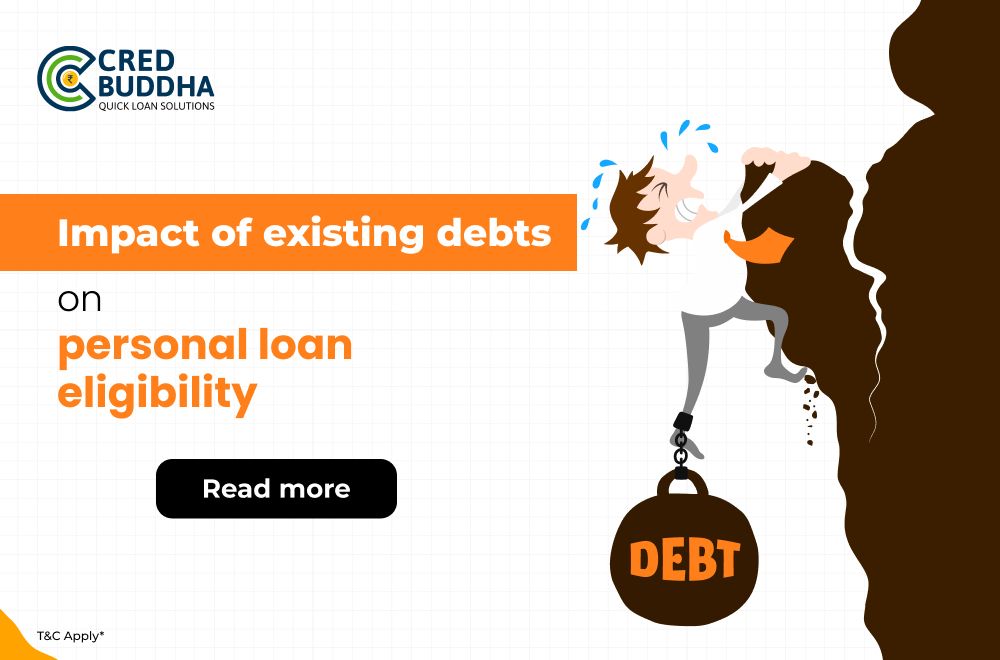
Impact of Existing Debts on Personal Loan Eligibility
Impact of Existing Debts on Personal Loan Eligibility
Let’s set the scene.
You’ve been paying your EMIs on time. Your credit card isn’t maxed out. You’ve got a stable job with a decent salary. Everything seems to be in place.
Then you apply for a personal loan — and suddenly, it’s a no from the lender.
Confused? You’re not alone. One of the sneakiest reasons people get rejected for personal loans is something they never saw coming: existing debt.
Yes, that home loan EMI, those credit card bills, or even that little consumer durable loan from Diwali two years ago could be silently working against you. But don’t worry — this blog is your roadmap to understanding how, why, and what you can do about it.
Lenders Aren’t Judging You — They’re Judging Your Risk
Contrary to popular belief, lenders aren’t trying to be the villain in your financial story. They’re just trying to make sure you can comfortably repay what you borrow.
They do this by looking beyond just your salary slip. They dive deep into your financial commitments — current EMIs, credit card dues, credit score, and overall repayment history.
In short, they’re not just asking: “How much do you earn?”
They’re asking: “How much is already going out?”
And that’s where your existing debts start talking louder than your income.
DTI: The Silent Deal Breaker
If your finances were a movie, the Debt-to-Income Ratio (DTI) would be the quiet but powerful character that drives the plot.
DTI is calculated like this:
(Total Monthly EMIs ÷ Monthly Income) × 100
So, if you’re making ₹60,000 and your total EMIs add up to ₹30,000, your DTI is 50%. That means half your salary is already spoken for.
Lenders like to keep it under 40%. Anything higher? It’s like saying, “I’m already balancing a lot — and now I want to carry more.”
Not a comforting signal for someone about to lend you money.
When Debt Piles Up, So Does the Doubt
It’s not just about one or two EMIs.
If your credit report shows:
Then even if you’ve never missed a payment, your profile starts to look risky.
Lenders worry you’re living too close to the edge — and one unexpected expense could topple everything.
Your Credit Score Is Watching Everything
Your credit score is like that quiet observer who notices everything — the good, the bad, and the financially questionable.
Most people believe timely payments = great credit score. But that’s only part of the story.
Your credit score also depends on:
So, even if you never defaulted, just having too much debt or applying for multiple loans in a short time can drag your score down. And a lower score? That’s strike two on your personal loan application.
Small EMIs, Big Impact
Think those ₹1,200 EMIs for your smartwatch or that ₹3,500 EMI for your fridge don’t matter?
Think again.
Every EMI, no matter how small, is considered by lenders. And when they’re stacked up — phone EMI, TV EMI, laptop EMI, and a credit card bill — they add up.
Suddenly, your financial bandwidth looks much narrower than it is. And personal loans need room to breathe.
Rejections Don’t Happen by Accident — They Follow Patterns
Here’s a reality check: banks don’t reject you out of nowhere. It’s all in the numbers.
Here’s how existing debts trigger red flags:
Lenders like stability. If your financial report reads like a thriller, they’ll opt out.
But There’s Good News: You Can Get a Loan (With Strategy)
Here’s the twist — existing debts don’t mean your personal loan dreams are over.
It just means you need a smarter game plan.
1. Clear Small Debts First
Start with low-balance loans or high-interest cards. It’s the fastest way to reduce your DTI and improve your credit report.
2. Pause the Credit Hunt
Don’t keep applying everywhere. Every new application is a hard inquiry that chips away at your score.
3. Consolidate Like a Pro
Merge multiple loans into one with a better rate. Fewer EMIs, more breathing space.
4. Boost Your Income (Even Temporarily)
Freelance. Weekend gigs. Commission bonuses. Every bit helps your DTI and your confidence.
5. Audit Your Credit Report
It’s not uncommon for reports to have outdated or wrong info. Clean it up and reclaim your eligibility.
Apply at the Right Time — Not in the Heat of the Moment
Timing makes all the difference.
If you’ve just taken a new loan, or your credit usage is peaking, wait a few months.
Let your score recover. Pay off something. Let your DTI drop.
Apply when your numbers speak for you — not against you.
Let’s be real — keeping track of your credit score, EMIs, DTI, and loan offers can feel like trying to solve a Rubik’s cube… blindfolded.
That’s where CredBuddha walks in like the calm in your financial storm.
CredBuddha doesn’t just show you your credit score — it explains it. It tells you what’s holding you back, how to fix it, and when to apply for a loan.
Even better? It matches you with lenders who are actually willing to lend based on your current financial profile.
No guesswork. No rejections. No stress.
From Debt-Heavy to Loan-Ready: That’s the CredBuddha Way
You don’t have to be debt-free to get a personal loan. You just have to be financially aware — and strategic.
With tools like CredBuddha guiding the way, you can go from confused and frustrated to confident and in control.
Because borrowing money shouldn't feel like a gamble. It should feel like a well-calculated move — with a trusted partner at your side.